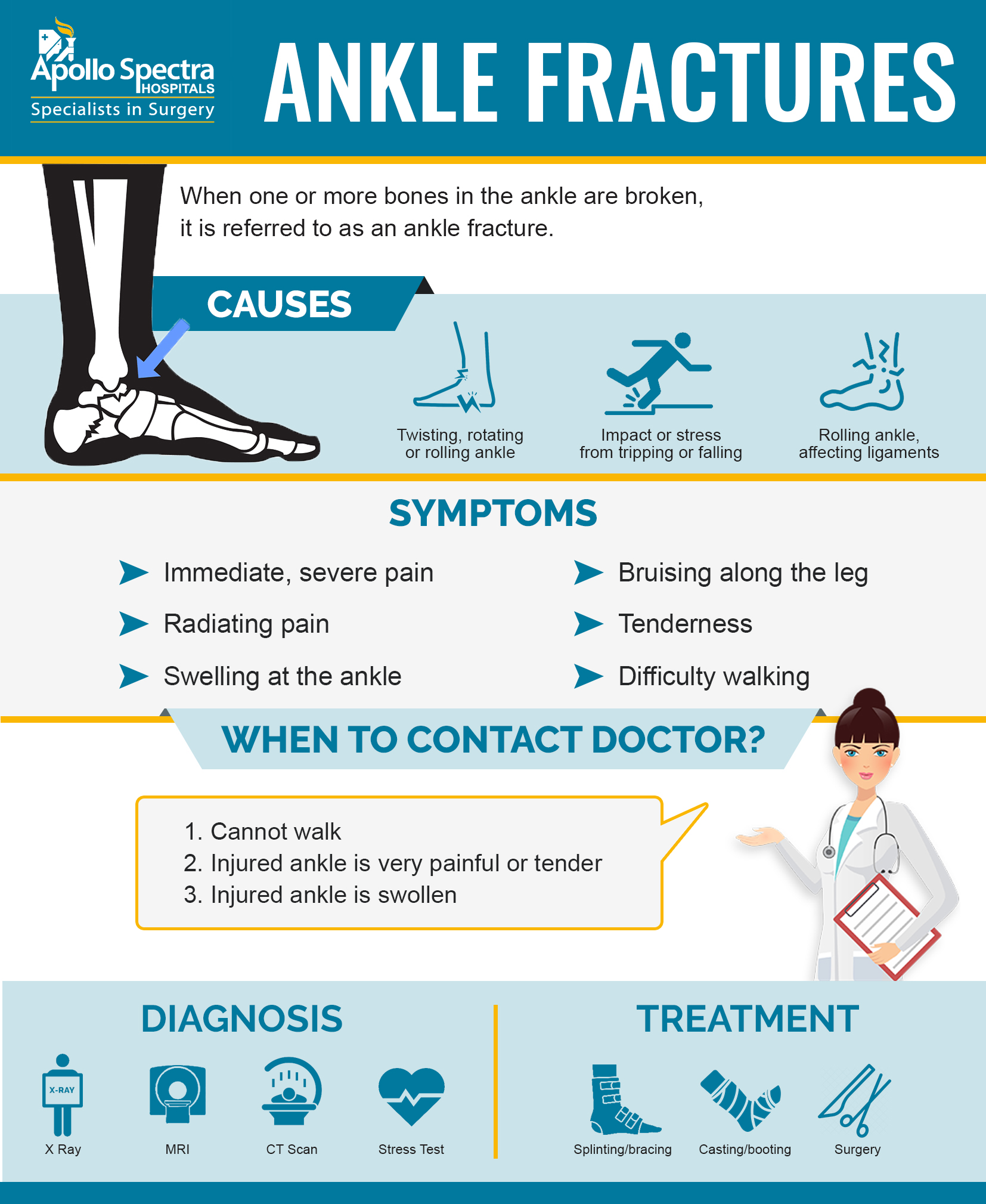Understanding Ankle Fracture, When should you seek help from a Doctor?
May 21, 2019
Ankle fractures
Ankle fractures are the most common type of bone and joint injuries. One needs to seek an emergency room because an ankle fracture may leave you unable to walk. The ankle joint is made up of the following:
- Tibia – Lower leg’s main bone that makes up the inside (medial) of the ankle joint.
- Fibula – It is the smaller bone that is present parallel to the tibia present in the lower leg. It makes up the outside (lateral) of the ankle joint.
- Malleoli is the far ends of the tibia and fibula. It forms an arch that sits on the top of the talus.
Apart from these 3 bones that make up for the bony elements of the ankle, there is a fibrous membrane named as joint capsule that encases the joint architecture. Joint capsule is lined with Synovium, a smoother layer. The synovial fluid, produced by the Synovium, is present in the joint capsule that allows the smooth movement of the joint surfaces.

There are several ligaments, fibers holding the bones in place, present in the joint that stabilized it.
Ankle Fractures Symptoms
The symptoms of the ankle fracture can be easily identified:
- Immediate and severe pain at the affected site
- Swelling
- Tenderness
- Radiating pain
- Bruising
- Difficulty putting weight on ankle
- Blisters
- Bones protruding through the skin
Ankle Fractures Causes
An ankle injury is caused when an ankle joint is stressed beyond the strength of its elements. Here are some causes for that extensive stress:
- You might sprain the ankle when the ligaments give wear and tear.
- In some cases, the bone gives away, resulting in the fracture.
- Ligaments can be torn in several ways including:
- Twisting the ankle towards the side
- Rollin the ankle in or out
- Extending or flexing the joint
- Applying extensive force to the joint by jumping from a higher level or coming straight down on it.
When should you seek medical care?
When it comes to an injured ankle, there are certain situations in which you should consult a doctor immediately:
- You can no longer bear any weight on your ankle.
- Even after taking all the pain medications, you are not able to tolerate the pain.
- No home care treatment is relieving you of your pain.
Here are some signs you should look out for:
- Visibility of bones outside the skin
- Inability to move your toes or ankles
- Deformity of the ankle bones
- Partial or total numbness in the ankle
- Blue or cold foot
- Intolerable pain even after taking pain medications
When the doctor starts the evaluation of your ankle, he will check whether the bone has fractured or the joint has become unstable due to repeated damage. Joint instability is caused by ligament injury or multiple fractures.
The doctor must be completely aware of the injury like where it hurts, how long ago it happened, how did it happen, did you hear a pop or a crack, does any other body part hurts, were you able to walk after injury, etc. These questions are important because the mechanism of the injury will determine the pattern of the fracture and the treatment it follows.
Next, a physical exam will be performed to lookout for the following:
- Swelling, bleeding and tissue damage
- Bruising, cuts, or abrasions
- Joint instability and fluid in the joint
- Injured blood vessels
- Pain, deformities and movement of the broken bones
- Looseness of the joint
- Tear in the ligaments
- Movement in your foot and ankle
The doctor will then ask for an X-ray of the ankle, knee, shin, or foot depending on the injury and the pain.
Treatment for Ankle fractures
Until you get the proper medication, you should try the following:
- Stay off the injured ankle
- Elevate the ankle to reduce pain and swelling
- Apply ice packs to the injured area. Remember to not use the ice directly.
- If available, take an ibuprofen because it will reduce pain as well as inflammation.
Now, depending on the type of injury, instability or fracture, the doctor will determine your treatment.
- If the bones are misaligned, before putting the cast or splint, the doctor must realign them. This realignment of bones might require an operation if the bone has broken through the skin. This is known as a compound fracture.
- Do not put any weight on your ankle.
- After the swelling has reduced, the doctor will place a splint or cast on your ankle. Now, this can either be a walking cast which can take on some weight or it can be a non-weight-bearing-cast that will require crutches for you to walk.
- Some strength pain medication might be prescribed to you depending on the degree of the pain. Do not operate heavy machinery or drive while using these medications.
NOTICE BOARD
CONTACT US
CONTACT US
 Book Appointment
Book Appointment


.svg)
.svg)
.svg)
.svg)








